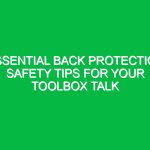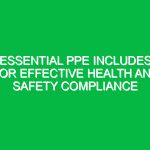Introduction
Personal Protective Equipment (PPE) is a critical component in the Health, Safety, and Environment (HSE) domain. PPE equipment examples encompass a wide variety of tools and garments designed to protect workers from Hazards that can cause injury or illness. Each piece of equipment serves a specific purpose, reflecting the diverse risks present in various work environments. From construction sites to laboratories, proper PPE can mean the difference between Safety and serious harm.
Understanding PPE and its relevance in HSE is crucial for employers and employees alike. The right PPE not only protects workers but also enhances overall Workplace Safety culture. This article will delve into essential PPE equipment examples, discussing their importance, types, regulations, and Best Practices to ensure HSE Safety success.
Key Aspects of PPE Equipment Examples
PPE equipment examples are categorized based on their functions and the types of Hazards they protect against. The following sections explore various categories of PPE, detailing their significance in the HSE context.
1. Head Protection
Head protection is vital in environments where there is a risk of falling objects or head injuries. Hard hats are the most common PPE equipment examples in this category. They are designed to absorb impact and can prevent serious injuries.
- Types of Hard Hats: There are various types of hard hats, including Type I and Type II, which differ in the level of protection they offer.
- Standards: Hard hats must meet the Standards set by organizations such as the American National Standards Institute (ANSI) and the Occupational Safety and Health Administration (OSHA).
Investing in quality head protection can save lives. For instance, a construction worker in New York City was saved from serious head injury when a falling tool struck his hard hat, which absorbed the impact.
2. Eye and Face Protection
Workers are often exposed to hazards like flying particles, chemicals, or intense light. Eye and face protection includes Safety Goggles, face shields, and Safety Glasses. These PPE equipment examples are crucial in preventing eye injuries.
- Safety Goggles: Designed to provide a snug fit around the eyes, they protect against dust, debris, and chemical splashes.
- Face Shields: Used in conjunction with safety goggles, face shields protect the entire face from hazards.
A notable incident involved a laboratory technician who suffered a chemical splash in the eye. Fortunately, wearing safety goggles prevented permanent damage.
3. Hearing Protection
Noise-induced hearing loss is a significant occupational risk. PPE equipment examples for hearing protection include earplugs and earmuffs.
- Earplugs: These are inserted into the ear canal to reduce noise exposure.
- Earmuffs: These cover the entire ear and provide a higher level of noise reduction.
In a manufacturing plant, workers exposed to loud machinery were equipped with earmuffs. Regular monitoring ensured that their hearing remained intact, demonstrating the effectiveness of proper PPE.
4. Respiratory Protection
Respiratory hazards can arise from dust, fumes, vapors, and gases. Respirators are crucial PPE equipment examples that protect workers’ lungs.
- Types of Respirators: These include N95 masks, half masks, and full-face respirators, each designed for specific levels of contamination.
- Fit Testing: Regular fit testing ensures that respirators form a proper seal and provide adequate protection.
During a hazardous materials cleanup, workers wore full-face respirators to shield against toxic fumes. This precaution helped prevent respiratory illnesses among the crew.
5. Hand Protection
The hands are vulnerable to cuts, burns, chemicals, and Electrical Hazards. Gloves are among the most common PPE equipment examples for hand protection.
- Types of Gloves: Cut-resistant gloves, rubber gloves, and heat-resistant gloves each serve unique purposes based on the risks involved.
- Material Considerations: Choosing the right material is essential for effective hand protection, particularly in environments involving hazardous substances.
In a food processing plant, workers used cut-resistant gloves while handling sharp tools. These gloves significantly reduced injuries and improved overall safety.
6. Foot Protection
Foot injuries can occur from slipping, falling objects, or punctures. Safety footwear, including steel-toed boots and slip-resistant shoes, is essential PPE in many industries.
- Steel-Toed Boots: These boots protect against impact and compression, making them ideal for construction sites.
- Slip-Resistant Shoes: These shoes reduce the risk of falls in wet or slippery conditions.
A warehouse worker who dropped a heavy box on his foot was unharmed, thanks to his steel-toed boots. This incident highlights the importance of investing in quality footwear.
Potential Hazards and Safety Considerations
While PPE is essential for safety, it is not a standalone solution. Identifying potential hazards is the first step in establishing an effective safety program. Employers should conduct thorough risk assessments to determine which PPE equipment examples are necessary for their specific environments.
Additionally, proper Training on PPE usage is crucial. Workers must understand how to wear, maintain, and store their equipment. Regular inspections and replacements of worn or damaged PPE can further enhance safety.
Regulations and Standards Governing PPE
PPE use is subject to various Regulations and standards that ensure its effectiveness and reliability. In the United States, osha sets forth guidelines for PPE, requiring employers to assess hazards and provide appropriate equipment.
- OSHA Standards: Employers must comply with standards such as 29 CFR 1910.132, which outlines general requirements for PPE.
- ANSI Standards: ANSI establishes performance and testing criteria for various PPE, ensuring that equipment meets safety benchmarks.
Understanding these regulations is vital for both employers and employees. Compliance not only protects workers but also mitigates legal risks for organizations.
Best Practices for PPE Use
To maximize the effectiveness of PPE, organizations should adopt Best Practices that foster a culture of safety. This includes:
- Regular Training: Conduct training sessions to ensure workers are familiar with the proper use and limitations of their PPE.
- Maintenance and Inspection: Implement a routine schedule for inspecting and maintaining PPE to prolong its lifespan.
- Encourage Reporting: Foster an environment where workers feel comfortable reporting issues with their PPE or potential hazards.
By prioritizing these practices, companies can create a safer workplace and reduce the likelihood of accidents and injuries.
Conclusion
The significance of PPE equipment examples in the HSE domain cannot be overstated. From head protection to foot protection, each type of PPE plays a vital role in safeguarding workers against various hazards. By understanding the different types of equipment available, adhering to regulations, and implementing best practices, organizations can cultivate a safety-conscious culture that prioritizes health and well-being.
As we move forward in an increasingly complex work environment, the commitment to PPE excellence will not only protect lives but also promote environmental Sustainability. Workers should feel empowered to advocate for their safety, ensuring that they are equipped with the appropriate PPE for their tasks. In the end, the success of any HSE program hinges on a holistic approach that values safety as a shared responsibility.


